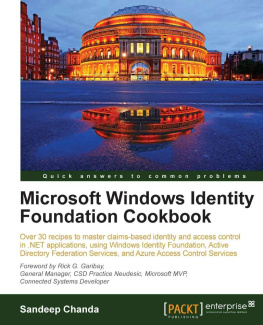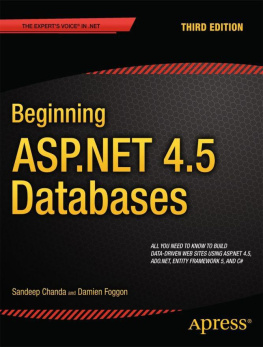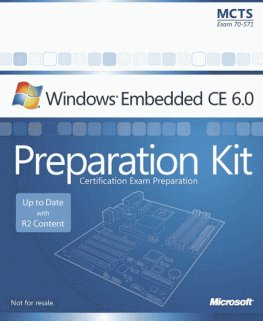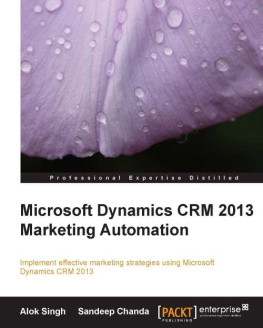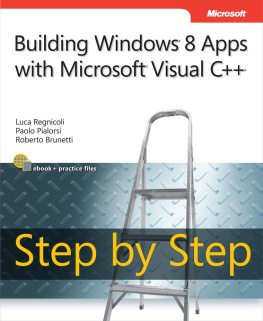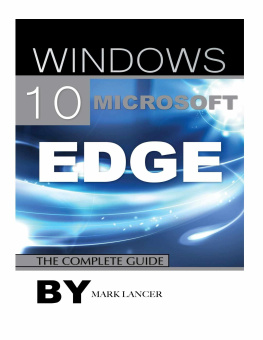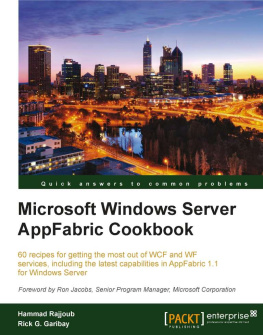Sandeep Chanda - Microsoft Windows Identity Foundation Cookbook
Here you can read online Sandeep Chanda - Microsoft Windows Identity Foundation Cookbook full text of the book (entire story) in english for free. Download pdf and epub, get meaning, cover and reviews about this ebook. year: 2012, publisher: Packt Publishing, genre: Computer. Description of the work, (preface) as well as reviews are available. Best literature library LitArk.com created for fans of good reading and offers a wide selection of genres:
Romance novel
Science fiction
Adventure
Detective
Science
History
Home and family
Prose
Art
Politics
Computer
Non-fiction
Religion
Business
Children
Humor
Choose a favorite category and find really read worthwhile books. Enjoy immersion in the world of imagination, feel the emotions of the characters or learn something new for yourself, make an fascinating discovery.
- Book:Microsoft Windows Identity Foundation Cookbook
- Author:
- Publisher:Packt Publishing
- Genre:
- Year:2012
- Rating:5 / 5
- Favourites:Add to favourites
- Your mark:
- 100
- 1
- 2
- 3
- 4
- 5
Microsoft Windows Identity Foundation Cookbook: summary, description and annotation
We offer to read an annotation, description, summary or preface (depends on what the author of the book "Microsoft Windows Identity Foundation Cookbook" wrote himself). If you haven't found the necessary information about the book — write in the comments, we will try to find it.
Microsoft Windows Identity Foundation Cookbook — read online for free the complete book (whole text) full work
Below is the text of the book, divided by pages. System saving the place of the last page read, allows you to conveniently read the book "Microsoft Windows Identity Foundation Cookbook" online for free, without having to search again every time where you left off. Put a bookmark, and you can go to the page where you finished reading at any time.
Font size:
Interval:
Bookmark:
Copyright 2012 Packt Publishing
All rights reserved. No part of this book may be reproduced, stored in a retrieval system, or transmitted in any form or by any means, without the prior written permission of the publisher, except in the case of brief quotations embedded in critical articles or reviews.
Every effort has been made in the preparation of this book to ensure the accuracy of the information presented. However, the information contained in this book is sold without warranty, either express or implied. Neither the author nor Packt Publishing, and its dealers and distributors will be held liable for any damages caused or alleged to be caused directly or indirectly by this book.
Packt Publishing has endeavored to provide trademark information about all of the companies and products mentioned in this book by the appropriate use of capitals. However, Packt Publishing cannot guarantee the accuracy of this information.
First published: April 2012
Production Reference: 1170412
Published by Packt Publishing Ltd. Livery Place 35 Livery Street Birmingham B3 2PB, UK.
ISBN 978-1-84968-620-4
www.packtpub.com
Cover Image by David Gutierrez ( <>)
Author
Sandeep Chanda
Reviewers
Senthil Kumar
Pushpendra Singh
Acquisition Editor
Rukshana Khambatta
Development Editor
Shreerang Deshpande
Technical Editors
Devdutt Kulkarni
Vrinda Amberkar
Project Coordinator
Michelle Quadros
Proofreaders
Clyde Jenkins
Linda Morris
Indexer
Hemangini Bari
Graphics
Valentina D'Silva
Manu Joseph
Production Coordinator
Arvindkumar Gupta
Cover Work
Arvindkumar Gupta
I still remember sitting down with my brand new copy of Writing Secure Code by Michael Howard and David LeBlanc. Having moved beyond writing relatively simple intranet web reports, (before the term "BI" came to embody what at the time we thought was an incredibly innovative way to display call center metrics for managing credit card operations) I found myself in a development lead position responsible for building a web portal for managing the collections process for JP Morgan Chase's auto and home business. The portal interfaced with a number of internal assets, such as SQL Server, Oracle, and IBM Mainframes via Terminal 3270 emulation, as well as external partners, such as Experian and Equifax.
In addition to the learning curve of moving from Classic Active Server pages to production-worthy .NET Framework 1.1 and ASP.NET Web Services, we were just beginning to dramatically disrupt the enterprise as a way to minimize the friction between systems while increasing the reusability of these integration investments. As a fledgling new lead, building the portal to stop world hunger and to cure cancer (as all the intranet portals promised to do in those days), I was keenly aware that the solution had to be secure, because after all, "All Input Is Evil", and working in the financial services industry, no security breach or personal information leak goes unpunished, no matter how trivial.
For weeks I skimmed through the 600 page volume, incrementally building confidence that I was doing my due diligence in implementing a trusted subsystem, identifying and authenticating my users, applying the least privilege, and preventing the SQL injection attacks.
Things were significantly simpler in 2003. All of my users were in Active Directory, and as long as I didn't need them to do multiple hops, NTLM was just fine, thank you very much. I put a lot of thought into the roles and proudly remember showing my manager how the new users would automatically have access to the portal as soon as their account was created (provided IT assigned them to the right group!  ).
).
Well, it turns out this "Web Services" thing was real, and what they did for the enterprise a decade ago pales in comparison to how service orientation has transformed the way users expect to be able to interact with software today. The proliferation of modern web applications and mobility demand a completely new perspective when designing modern applications. Whether you are building Web, desktop, or mobile solutions that reside on-premise, on the cloud, or are a hybrid thereof, identity and access control have never been more important.
Whether in the enterprise or consumer space, today's users demand access to your application from anywhere and at any time. And, for your applications to compete in the market and provide real value, they must compose a variety of assets, that is public and private, each of which carry their own requirements for authentication and authorization. In short, modern applications must be claims-aware .
While the options for federating identity and access control across the public and corporate assets are both varied and daunting, they also present the tremendous opportunities for unlocking the potential of your applications in taking advantage of the existing investments at a global scale. To enable this new breed of applications, Microsoft provides the Windows Identity Framework (WIF) , which aims to simplify working with claims-based security by providing standardized APIs, templates, and tools that make the process of accessing, interpreting, and mapping claims tenable.
Initially provided as a standalone framework (previously known as Geneva), WIF is now included as a part of .NET 4.5, which is in beta at the time of writing this book. The inclusion of WIF in .NET is not merely a packaging decision, but a clear reflection of the commitment that Microsoft has made to this powerful security framework.
As such, Sandeep's book couldn't come at a better time.
Careful to begin with easy-to-grasp fundamentals of claims-based security, Sandeep progresses through the common WIF programming tasks using examples in ASP.NET and WCF familiar to the most .NET developers, while covering bleeding-edge scenarios including new features exposed in Windows 8 and securing Windows Metro applications.
This book offers a combination of simple, intermediate, and advanced scenarios, covering AD FS 2.0 and incorporating web identity providers such as Windows Live ID, Google, Yahoo!, and Facebook with Azure Service Bus Access Control Service. Also covered are the real-world scenarios that you are likely to encounter for securing Microsoft SharePoint, SalesForce.com, and Microsoft Dynamics CRM.
In addition to providing a hands-on pragmatic reference that will be immediately valuable to your next project, this book is a reflection of Sandeep's real-world experience, successfully applying these concepts and techniques in the field, the value of which is worth the price of this book alone.
If you are serious about building claims/identity-aware services and the applications on .NET Framework, and want to get started today, this book belongs in your library.
Rick G. Garibay
General Manager, CSD Practice Neudesic
Microsoft MVP, Connected Systems Developer
Sandeep Chanda is a Director of Solutions at Neudesic, a Microsoft National Systems Integrator and Gold Certified Partner. He has been working on several Microsoft Technologies (including but not limited to .NET, BizTalk, SharePoint, and Dynamics CRM) for the past seven years, of which the last couple of years were spent on building claims-aware applications for leading companies in the Manufacturing and Hospitality domains. He is a technology enthusiast and a speaker at various corporate events and public webinars. He has authored several articles on Microsoft Dynamics CRM 4.0 in a popular online developer magazine. Most recently, he has been involved in evangelizing the aspects of Application Lifecycle Management and developer collaboration, using Team Foundation Server 11 Beta. He also spends quite a bit of time travelling and training the different teams on the new features of .NET Framework 4.5 and Windows 8 Metro application development. Sandeep holds an MS degree in Software Systems from BITS Pilani, and his areas of interest include Service-oriented Computing, Pervasive Computing, and Haptic Devices. He occasionally blogs at >.
Font size:
Interval:
Bookmark:
Similar books «Microsoft Windows Identity Foundation Cookbook»
Look at similar books to Microsoft Windows Identity Foundation Cookbook. We have selected literature similar in name and meaning in the hope of providing readers with more options to find new, interesting, not yet read works.
Discussion, reviews of the book Microsoft Windows Identity Foundation Cookbook and just readers' own opinions. Leave your comments, write what you think about the work, its meaning or the main characters. Specify what exactly you liked and what you didn't like, and why you think so.

